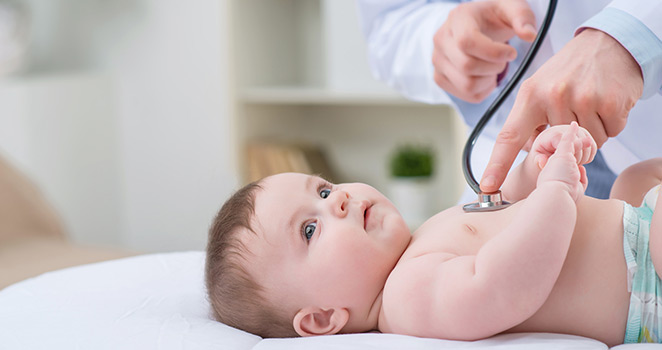Pediatric Congenital Conditions

Congenital Orthopedic Conditions
An orthopedic defect is a physical problem affecting the skeleton, muscles and/or related tissues. Some orthopedic defects are acquired, and others are congenital. In 60 percent of the cases, the cause of a congenital orthopedic defect is unknown, according to the March of Dimes. Chromosomal disorders, heredity, or toxins like alcohol or certain medications might cause other forms. Certain medical conditions or diseases affecting the mother, like diabetes or German measles, can also cause a congenital defect.
There are many kinds of congenital conditions, and they vary widely from mild to crippling to life threatening. Some conditions go away on their own, while others require extensive treatment.
Clubfoot
Clubfoot is the most common congenital orthopedic defect and appears in one to three out of every thousand births. Also called talipes equinovarus, it is a foot deformity. It can affect one or both feet and is twice as common in boys as it is in girls. Some children with clubfoot are also born with a hip condition like hip dysplasia.
In clubfoot, the affected foot is typically short and broad. The heel, which can look abnormally narrow, points downward, and the front of the foot turns inward. The calf muscles are smaller than normal, and the Achilles' tendon is abnormally tight.
While clubfoot is not painful, it will make it hard for the child to walk if it is not treated. In the United States, the most common method for treating clubfoot is the Ponsetti method, which the doctors will usually start implementing treatment shortly after birth. The Ponsetti method involves manipulating the foot into a normal position and then wrapping it in a cast to keep it that way. This part of the treatment takes six to eight weeks. Afterward, the doctor will perform an operation called an Achilles tenotomy to loosen the Achilles' tendon. It typically takes three weeks for the tendon to fully heal. To prevent the clubfoot from recurring, the infant will have to wear a "boots and bar" brace until they are around three or four years old.
The French method is another non-surgical treatment, and it involves stretching the foot to increase its range of motion. The therapist will then tape the foot to maintain that gain. If the non-surgical treatments fail, the child will need surgery to correct their clubfoot.
Developmental Dysplasia of the Hip
Also known as, DDH, developmental dysplasia of the hip is another common birth defect that occurs in about one out of every 1,000 live births. It affects more girls than boys.
The hip is a "ball and socket" joint. Normally, the ball-like head of the femur fits snugly into the socket of the hip. In DDH, the hip is either prone to dislocating or is completely dislocated. In severe cases, the problem is a shallow or malformed hip socket that cannot accommodate the head of the femur. Symptoms of hip dysplasia can include an abnormally wide space between the legs, less mobility or flexibility in the affected leg, uneven skin folds on the buttocks, and one leg appearing shorter than the other does.
As with clubfoot, the sooner hip dysplasia is treated the better. Untreated hip dysplasia will impair a child's ability to walk. The treatment options vary depending on the age of the child. Non-surgical methods like braces or casts will be tried first. If they fail, or the child is over two years old, the doctor will perform surgery to correct the problem.
Muscular Dystrophy
Muscular dystrophy or MD is a group of diseases that affect the muscles. It is a genetic disorder, and there are nine types. Depending on the type, a patient may show symptoms as a child or not until adulthood. The two most common forms affecting children are Duchenne MD and Becker MD, and both are sex-linked disorders that nearly always affect only boys. While there is no cure, there are treatments to retard the degeneration of the patient's muscles and improve the quality of their lives.
Duchenne MD is a more severe form. Boy's typically start-showing symptoms when they are between two and five years old. They start losing muscle strength in their pelvis, upper arms, and legs. They have trouble getting up from a prone or sitting position on the floor, and they have trouble running or jumping. As their condition progresses, fat deposits replace the muscles in their legs, and they are using wheelchairs by late childhood. As the condition moves on to the muscles in their back and chest, the child develops curvature of the spine. By their teens, the disease is attacking the heart and respiratory muscles. Until very recently, most boys with Duchenne MD died in their teens, but improved treatments have enabled some patients to survive into adulthood. A few patients have even survived into middle age.
While Becker MD has symptoms similar to Duchenne MD, they are less severe and appear later. In some cases, a child with Becker MD may seem normal until their teens. Assuming the heart problems are relatively mild, a man with Becker can have a normal lifespan.
Treatments for both types of muscular dystrophy include medications like corticosteroids to slow down the degeneration of the muscles. The patient will also undergo physical therapy and wear braces to try to remain as mobile as possible for as long as possible. They will also use devices like walkers and wheelchairs. If some symptoms, like scoliosis, get severe enough, the patient may need surgery.